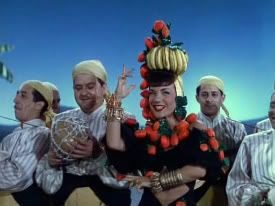|
The Gang's
All Here (1943) |
|
Synopsis Analysis The story the director tells is, frankly, utterly contrived, but it is never dull. The viewer might not be deeply moved by the protagonists' troubles or profoundly immersed in their lives, but he is still likely to find himself interested and amused by these individuals and their actions. Happily, the characters are consistently nicely drawn. Andy is a likeable scoundrel who gleefully deceives Edie in order to win her heart, not only failing to tell her about his fiancée, but lying about his name as well. Dorita is sexy, conniving, and given to malapropisms, and Edie is happy, optimistic, and trusting. There is not a character in the film who is not engaging. What is more, the movie does include a number of well done comic moments. Besides the endless complicated misunderstandings, near exposures, and the like with which the plot is filled, there are hilarious scenes revealing how Dorita gets far too friendly with Vivian's father, Peyton Potter (Edward Everett Horton), repeatedly kissing him and so smearing his face with her lipstick, how that man's wife (Charlotte Greenwood), who, years before, had scandalously lived as a dancer in Paris, takes part in an energetic dance with a young man at a lawn party, how the prudish, teetotaling Peyton overreacts when presented with performers and alcoholic beverages, and so on and so on.. Despite such merits, the greatest appeal of The Gang's All Here is its musical numbers. I cannot begin to express how fun these are to watch. They range from simple, romantic numbers, such as that in which Edie sings to Andy while sitting beneath the moon on a ferry, to the comic, such as that mentioned above, in which Mrs. Potter preforms a high kicking dance with a young man, to the lavish, such as the opening number, in which Dorita sings a variation of "Brazil" on an incredibly elaborate stage crowded with props and bustling with performers. There are, however, two numbers that really stand out with their Technicolor brilliance, dreamlike images, and complicated choreography, Carmen Miranda's "The Lady in the Tutti-Frutti Hat" and Alice Faye's "The Polka Dot Polka." In the first of these, Berkeley presents the viewer with a forest of cloth-leaved banana trees below which reclines an army of young women, who promptly rise up and, while wielding bananas nearly as tall as they are, perform a complicated dance during which they form kaleidoscopic patterns with their bodies; finally, at the song's end, Carmen Miranda reappears to stand between rows of giant strawberries with an impossible triangular mass of bananas exploding from her turban. The number is lavish and wonderfully strange. "The Polka Dot Polka" is just as odd and mesmerizing. After showing Alice Faye dancing with a group of children, Berkeley cuts to a troupe of women manipulating gigantic polka dots (parts of which segment are shown in reverse). The director then goes on to reveal neon hula hoops floating in some black space, human forms dissolving into wild, colored patterns when the number is, apparently, filmed through an actual kaleidoscope, and the singing heads of his characters floating across an otherwise empty blue screen. The number is certainly unique. With such performances, which make up a substantial portion of the movie, The Gang's All Here is always alive with music and dance. Fortunately, all these numbers are a joy to watch and greatly enhance the film's plot, which, as I have mentioned, is entertaining on its own. The Gang's All Here truly is fun to watch. Review by Keith Allen
Home Page / Alphabetical List of
Films © 2009 movierapture@hotmail.com Keith Allen. All rights reserved. |










